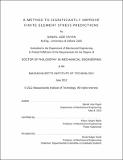A method to significantly improve finite element stress predictions
Author(s)
Payen, Daniel Jose
DownloadFull printable version (4.001Mb)
Other Contributors
Massachusetts Institute of Technology. Dept. of Mechanical Engineering.
Advisor
Klaus-Jürgen Bathe.
Terms of use
Metadata
Show full item recordAbstract
In this thesis, we present a novel method to improve the finite element stress predictions in static, dynamic and nonlinear analyses of solids. We focus on the use of low-order displacement-based finite elements, 3-node and 4-node elements in two-dimensional (2D) solutions, and 4-node and 8-node elements in 3D solutions -- because these elements can be computationally efficient, provided good stress predictions are obtained. We give a variational basis of the new method and compare the procedure, and its performance, with other effective previously proposed stress improvement techniques. We observe that the stresses of the new method converge quadratically in ID and 2D solutions, i.e. with the same order as the displacements, and conclude that the new stress improvement method shows much promise for the analysis of solids, structures and multiphysics problems, to calculate improved stress predictions and to establish error measures. Highlights: --Novel stress improvement method is given for static, dynamic and nonlinear analysis of solids. --Focus is on the use of low-order elements. --Quadratic convergence is observed for the improved stresses. --Method is compared with existing techniques.
Description
Thesis (Ph. D.)--Massachusetts Institute of Technology, Dept. of Mechanical Engineering, 2012. Cataloged from PDF version of thesis. Includes bibliographical references (p. 123-129).
Date issued
2012Department
Massachusetts Institute of Technology. Department of Mechanical EngineeringPublisher
Massachusetts Institute of Technology
Keywords
Mechanical Engineering.